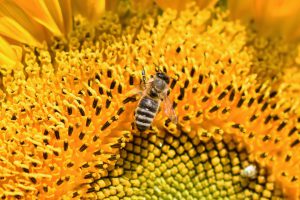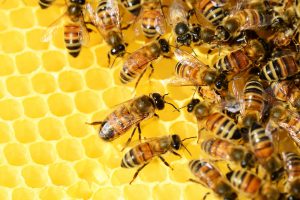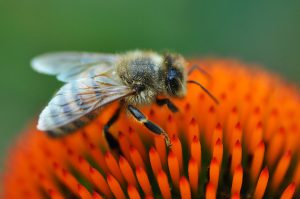NATIONAL HONEY BEE DAY
- NPG
- August 16, 2018
- NPG Commentary
- 0 Comments
NATIONAL HONEY BEE DAY – AUGUST 18TH
Celebrating Our Very Busy and Very Important Friends
It is traditional for all of us to have learned about “the birds and the bees” at a key point when we were growing up. However, the reality is that few of us really learned much about the bees.
Today, the most many of us know is that honey bees are crucial to pollinating crops and flowers – and have been experiencing a crisis in recent years that seriously threatens their future.
Thus, it is important for us to update our knowledge about America’s bees – and what better time than National Honey Bee Day that is observed today, August 18th.
According to Wikipedia, National Honey Bee Day started with a simple concept:
“Bring together beekeepers, bee associations, as well as other interested groups to connect with the communities to advance beekeeping. By working together and harnessing the efforts that so many already accomplish, and [by] using a united effort one day a year, the rewards and message is magnified many times over.”
NPG fights to ensure that too many people do not create environmental crises that threaten the fragile balance between nature and humans. Toward that end, we applaud the celebration of National Honey Bee Day and are pleased to take this opportunity to bring our members and supporters up-to-date on the current status of America’s bees.
First, let’s start with the fact that approximately one-third of all crops – particularly all fruits and non-grain vegetables – are pollinated by honeybees.
That being the case, it is understandable that major shockwaves – both economic and environmental – were triggered by reports of a growing crisis among bee colonies a bit more than a decade ago, that was labeled “colony collapse disorder” (CCD).
The brief history of CCD – and a positive update on where honeybees stand today, was put forth by Matt Miller, writing in Slate two years ago. In an article titled The Bees are Alright, Miller relates that:
“Ten years ago, a man named Dave Hackenberg discovered that bees were disappearing. Not dying, just disappearing. Unlike previous plagues where whole colonies could be wiped out, leaving a pile of bee bodies on the floors of the hives, this new wave of affliction was rendering hives completely empty, with no bodies for pathologists to examine, leading some bloggers to dub the phenomenon ‘the bee rapture.’
In the past decade, research has found that a new class of pesticides, neonicotinoids, increases the honeybees’ susceptibility to a specific parasite – the varroa mite (these mites have been around since the 1980s but weren’t known to cause any serious problems until the bees started disappearing).
 The strange thing is that no one knows exactly how the interaction of bad pesticides and this parasite caused bee colonies to collapse. Some researchers have argued that the pesticides make the queen more susceptible to varroa mite, which kills her reproductive capabilities and causes other members of the hive to give up and depart for greener pastures, so to speak. Others think it’s that the neonicotinoids cause a disruption in the homing mechanisms of the honeybees that prevents them from navigating back home, though it’s unclear how the mites play a role. In both cases, the result is the same: an empty hive.
The strange thing is that no one knows exactly how the interaction of bad pesticides and this parasite caused bee colonies to collapse. Some researchers have argued that the pesticides make the queen more susceptible to varroa mite, which kills her reproductive capabilities and causes other members of the hive to give up and depart for greener pastures, so to speak. Others think it’s that the neonicotinoids cause a disruption in the homing mechanisms of the honeybees that prevents them from navigating back home, though it’s unclear how the mites play a role. In both cases, the result is the same: an empty hive.
‘CCD was a real problem, probably six or seven years ago,’ says Jeff Pettis, an entomologist whose research played a major role in uncovering the causes of CCD. He adds that in the past three to five years, though, researchers in his field have as not seen much CCD and that globally honeybee populations are not in decline.
The reasons for this apparently miraculous departure from the fast-track toward extinction are not hard to understand, now that research has borne out the causes. First, both the U.S. and several European countries have passed regulations that restricts the use of pesticides and fungicides that are suspected to have played a role in CCD to begin with.
The second reason there’s no longer an immediate threat of extinction is that bees aren’t, say, giant pandas, an animal that is actually, seriously endangered. That is to say, bees can recover their population numbers reasonably quickly. Compared with the once-a-year ovulatory habits of pandas, queen honeybees regularly lay 1,500 eggs per day, and if the conditions call for it, can up that figure to as many as 2,000 eggs per day or more. Even if honeybee keepers report losing as much 30 to 45 percent of their bees in a single year, this doesn’t actually mean the honeybee population will decline by that much. The beekeepers’ response will be to simply leverage the queens’ enormous reproductive abilities, which will quickly recoup those losses.”
So, as we all come together to celebrate National Honey Bee Day this year we can all breathe a lot easier that CCD is not as severe as once expected.
But the reality is that population growth and urban sprawl still pose great peril to our nation’s bees.
In 2007, the Center for Biodiversity and Conservation at the American Museum of Natural History and the Greenbelt Native Plant Center launched the Great Pollinator Project (GPP), originally called the Bee Watchers project, in collaboration with the Great Sunflower Project in San Francisco, California. The Great Pollinator Project has posted this warning:
Major Threats to Pollinators
Bees and other insect pollinators are beset by the same environmental challenges as other species, including habitat loss, degradation, and fragmentation; non-native species and diseases; pollution, including pesticides; and climate change.
Habitat Loss, Degradation, and Fragmentation
Much pollinator habitat has been lost to agriculture, resource extraction, and urban and suburban development. Although these land uses can provide floral resources and benefit some pollinators, many bees and butterflies are habitat-specific, and the loss of habitat that provides sites for overwintering, foraging for pollen and nectar, or nesting can be detrimental to these species.
Habitat degradation, the decline in habitat quality, is another serious concern. For example, the loose, friable soil required by ground-nesting bees may be trampled by heavy foot traffic or the use of off-road vehicles. In cities, ground-nesting species may be particularly limited due to the large amount of landscape that has been covered with concrete or other impervious surfaces.
Many pollinators are adversely affected when large, intact tracts of habitat are broken up into smaller, isolated patches by road construction, development, or agriculture. These habitat fragments may not be large enough to meet all pollinator needs by themselves. Establishing and maintaining connectivity—safe passage among patches—is key to pollinator persistence in these areas.
Finally, if you wish to increase your personal knowledge about honeybees while celebrating National Honey Bee Day, consider these facts presented by Golden Blossom Honey.com
About the Work of the Honeybee
- The honeybee is not born knowing how to make honey; the younger bees are taught by the more experienced ones.
- Some worker bees are nurse bees. Their job is to feed the larvae.
- A honeybee visits between 50 and 100 flowers during one collection flight from the hive.
- In order to produce 1 pound of honey, 2 million flowers must be visited.
- A hive of bees must fly 55,000 miles to produce a pound of honey.
- One bee colony can produce 60 to 100 pounds of honey per year.
- An average worker bee makes only about 1/12 teaspoon of honey in its lifetime.
- At the peak of the honey-gathering season, a strong, healthy hive will have a population of approximately 50,000 bees.
- It would take approximately 1 ounce of honey to fuel a bee’s flight around the world.
- A Cornell University paper released in 2000 concluded that the direct value of honeybee pollination to U.S. agriculture is $14.6 billion annually.
- We should appreciate honeybees for their honey and pollination services. 80% of the pollination of the fruits, vegetables and seed crops in the U.S. is accomplished by honeybees.
- Honey is the primary food source for the bee. The reason honeybees are so busy collecting nectar from flowers and blossoms is to make sufficient food stores for their colony over the winter months. The nectar is converted to honey by the honeybee and stored in the wax honeycomb.
The United States has an estimated 211,600 beekeepers; and the top honey-producing states are: North Dakota which produced 33.6 million pounds in 2017, followed by South Dakota at 14.5 million, California at 13.7 million, Montana at 10.4 million and Florida at 8.8 million. Texas, Minnesota, Michigan, Louisiana, and Washington, also rank high on the list.
NPG applauds the work of America’s beekeepers and will continue to do all we can to raise alarms about how the “growth at any cost” political leaders and developers must be kept in check lest they greedily destroy, divide, or upset critically important bee habitats in fast-growing residential areas across the U.S.
SUPPORT NPG IN OUR FIGHT FOR A SUSTAINABLE FUTURE
MAKE A CONTRIBUTION TODAY!
Your gift helps publish and distribute materials like this.
NPG is recognized as a 501(c)(3) non-profit organization, and all contributions are tax-deductible to the extent the law allows.


